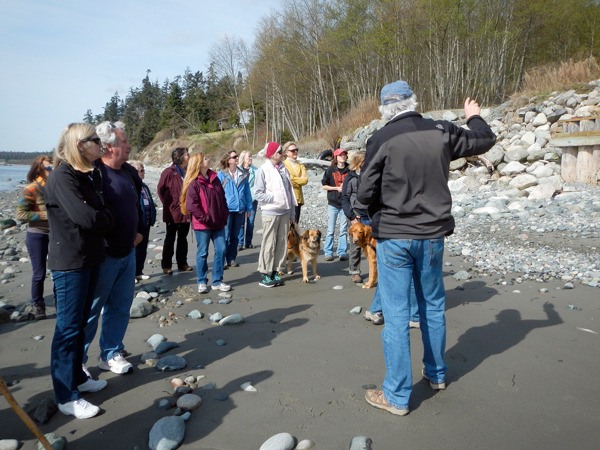Whidbey Island’s ecosystem is one of its most unique and delicate features. Oceanic and land-based flora and fauna intertwine in a complex chain, each link reliant upon the others to maintain the wellbeing of the whole.
Sound Waters, a one-day educational conference, presents Whidbey residents with the opportunity to learn more about the island and surrounding areas and the ways to help preserve them.
According to the conference website, around 500-600 island residents attend each year.
The conference will kick off with a keynote speaker presentation, after which attendees will have the option to choose from a variety of 63 classes during each of three sessions throughout the day. This year’s conference will feature 41 new presentations covering such topics as bees, raptors, owls, shellfish, salmon, crabbing, fishing, gardening, renewable energy, shoreline restoration and tsunamis. An additional 35 exhibits will be on display.
Keynote speaker and University of Washington Professor John Delaney will present “Our Global Ocean — The Ultimate Planetary Life Support System.” He will discuss the recent installation of the world’s largest Internet-connected ocean observatory, located off the West Coast of the United States.
The observatory employs robots which monitor the ocean from the surface of the water the ocean floor in order to better understand the ocean and its life-supporting properties.
Presentations include a screening of “Return of the River,” a film illustrating an element of hope amidst “grim” recent news regarding the environment. The film discusses the removal of the dam at Washington State’s Elwha River, “an unlikely success story for environmental and cultural restoration,” according to a press release.
Marky Olson, publicity chairwoman for Sound Waters, said that the Elwha River was one of the most striking things she learned about when she first joined Beach Watchers, the volunteer group responsible for hosting the Sound Waters conference.
Although Olson had read about the river and the dam’s implications, she said she didn’t give it much thought until seeing it firsthand. She attended a discussion of the river and the destructive impact of the former dam and said she was moved by a speech from a Native American presenter whose community depended upon the river’s natural resources.
At the end of the presentation, Olson recalled that a fellow Beach Watchers member asked the speaker how he felt the day the dam was destroyed.
“I’m not a very religious man,” he replied. “But on that day the sky was singing, the birds were singing and so were the mountains.”
Other presentations include “The Genesis of the Keystone Species Concept: How Apex Predators Drive the Diversity in an Ecosystem” by Dr. Robert Pain and “Conservation Meets Preservation: Exploring the Cultural Landscape of Ebey’s Landing National Historical Reserve” by Lynn Hyde.
Beach Watchers is a group of volunteers who act in coordination with the Washington State University Island County Extension Program. 
Each year, a new class of volunteers takes 100 hours of classes spanning subjects in “all things Puget Sound.” The group contributes more than 20,000 total volunteer hours a year, according to the organization’s website. Volunteer work includes collecting data on intertidal flora and fauna, juvenile salmon, forage fish, pigeon guillemots, water quality and shellfish monitoring. It also includes educating the public to be beach naturalists, ship naturalists and teachers at the South Whidbey School District’s Outdoor Classroom on Maxwelton Road, planning educational events and cleaning up litter and other debris.
“If we don’t understand what is happening and we don’t understand the beauty and power of the Salish Sea we won’t be able to save it,” Olson said. “The only way to save it is to be educated about it.”
The more individuals who know about sea and island ecosystems, she added, the more possible it will be to preserve them for future generations.
“I think the happiest part of my week is when I get down near the water,” Olson said. “I smell it and hear it and feel it and it is powerful. I wish more people would take the time to do that.”
Olson noted that there are several new environmental concerns that have come about since Sound Waters’ inception 20 years ago. Though she can’t say for sure what would become of the island if not for organizations like Beach Watchers, she surmised that there would be far less available data and research. The National Oceanic and Atmospheric Administration (NOAA), she explained, utilizes data collected by Beach Watchers since NOAA does not have the funds to employ enough people to do as much extensive research themselves.
“Beach Watchers is a force of humanity,” Olson said.
Clinton resident Linda Ridder, Sound Waters event chairwoman and Beach Watcher, became involved with the organization in 2005. Being a retired professor, said Ridder, education is of paramount importance to her. Sound Waters provides ample opportunity for residents to learn about dozens of topics from gray whales and sustainable gardening to government environmental policies and tsunamis, she added.
New and urgent issues such as ocean acidification, depletion of the salmon population and subsequent malnutrition in whales, heavy metal runoff, sea star deaths and a virus amongst the eel grass beds are current concerns for Beach Watchers and others.
Things can be fairly complex, said Ridder, and the idea of Sound Waters is to help residents understand these issues and the ways in which they can help.
“Anyone can come, from high school students to retired PhD scientists and housewives,” said Ridder. “It’s a place for everybody to get involved.”


